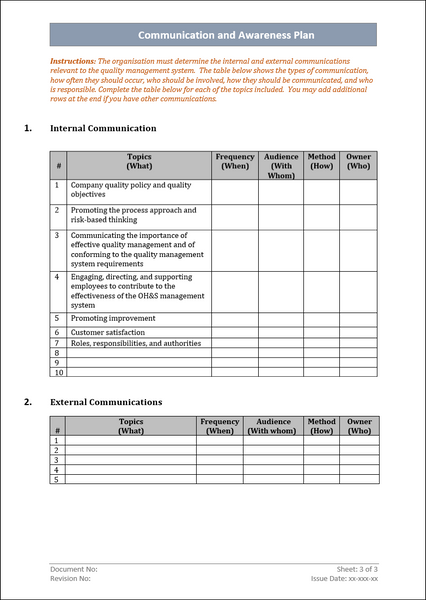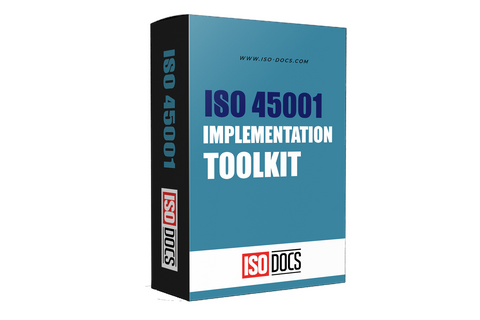ISO 45001 Communication and Awareness Plan Template
Introduction
Effective communication and awareness are essential to implementing ISO 45001, the international occupational health and safety management system standard. A well-designed Communication and Awareness Plan is crucial in ensuring that all employees and stakeholders are informed and educated about the requirements of ISO 45001 and their roles and responsibilities in maintaining a safe and healthy work environment. This blog will provide a comprehensive template and guidelines for creating an effective Communication and Awareness Plan concerning ISO 45001, empowering organizations to proactively address health and safety issues and achieve compliance with the standard.

Understanding The Importance Of Communication And Awareness In ISO 45001
Effective communication and awareness are crucial to adhering to ISO 45001, the international occupational health and safety management system standard. This standard emphasizes the need for organizations to establish clear communication channels and ensure that all employees know their roles and responsibilities in maintaining a safe working environment. Communication plays a vital role in preventing workplace accidents and incidents.
By promoting open and transparent communication, organizations can create a culture where employees feel comfortable reporting hazards, near misses, and potential risks. This enables timely identification and mitigation of hazards, reducing the likelihood of accidents and injuries.
Furthermore, effective communication ensures that all employees are informed about health and safety policies, procedures, and guidelines. Regular training programs and information-sharing sessions keep workers updated on the latest safety protocols and best practices. This awareness empowers employees to make informed decisions regarding their own and their colleagues' safety.
Evaluating and Improving Your Communication And Awareness Plan
1. Assess Your Current Plan: Evaluate your current communication and awareness plan. Identify its strengths, weaknesses, and areas for improvement. This could involve reviewing previous communication campaigns, analyzing feedback from stakeholders, or conducting surveys to gauge effectiveness.
2. Set Clear Objectives: Determine the goals and objectives you want to achieve through your communication and awareness plan. This could include increasing brand awareness, improving customer satisfaction, or enhancing public perception. Clearly defining your objectives helps you focus on measurable outcomes.
3. Segment Your Audience: Understand your target audience and break it down into distinct segments. Each segment may have different communication preferences and needs. Segmenting your audience enables you to create targeted messages and tailor your communication approach accordingly.
4. Develop A Message Strategy: Craft key messages that align with your objectives and appeal to your target audience. Your messages should be clear, concise, and easily understood. Consider using storytelling techniques or visuals to make your messages compelling and memorable.
5. Select Communication Channels: Identify the most effective channels to reach your target audience. These could include traditional media (e.g., newspapers, radio), digital platforms (e.g., social media, websites), or direct communication methods (e.g., email, in-person meetings). Consider your audience's preferences and habits when choosing channels.
6. Implement A Content Calendar: To ensure consistent and timely communication, create a content calendar. This involves planning and organizing your communication activities, including the frequency and timing of messages across different channels. A content calendar helps you convey your messages with a systematic and organized approach.
7. Monitor And Measure Impact: Continuously monitor the impact of your communication and awareness plan. Use analytics and feedback mechanisms to gather data on reach, engagement, and audience sentiment. Regularly review and assess the effectiveness of your plan to make necessary improvements and adjustments.
8. Seek Feedback And Adapt: Actively seek feedback from stakeholders, including employees, customers, and partners. Listen to their suggestions, concerns, and ideas for improvement. Incorporate their feedback into your plan to ensure it remains relevant, responsive, and impactful.
9. Enhance Cultural Sensitivity: When designing your communication and awareness plan, consider cultural differences and sensitivities. Ensure that messages, visuals, and gestures are culturally appropriate and avoid potential misunderstandings or offenses.
10. Training And Education: Invest in training and development for your communication team. This may include workshops on effective communication techniques, cross-cultural communication, or media relations. Equipping your team with the necessary skills and knowledge boosts their ability to execute the plan successfully.
Monitoring And Reviewing The Communication And Awareness Plan
- Define clear objectives and goals for the Communication and Awareness Plan.
- Identify the target audience and stakeholders for the communication efforts.
- Develop a timeline and schedule for communication activities.
- Determine the key messages and themes that need to be communicated.
- Select appropriate communication channels and tools to reach the target audience.
- Create content that is relevant, engaging, and easy to understand.
- Ensure consistency in messaging across different channels and platforms.
- Establish systems for monitoring and tracking the reach and impact of communication efforts.
- Conduct regular reviews and evaluations of the Communication and Awareness Plan.
- Seek feedback from the target audience and stakeholders to assess the effectiveness of the communication efforts.
- Make necessary adjustments and improvements based on the feedback received.
- Continuously update and iterate the Communication and Awareness Plan to align with changing needs and priorities.
Conclusion
In conclusion, having a well-defined Communication and Awareness Plan concerning ISO 45001 is essential for successfully implementing the standard. Organizations can use a template to ensure that all necessary information is communicated effectively and that employees are aware of their responsibilities regarding occupational health and safety. This template provides a comprehensive framework for developing a tailored plan that aligns with the organization's specific needs. Implementing this plan will help achieve compliance with ISO 45001, promote a culture of safety, and improve overall operational performance.


